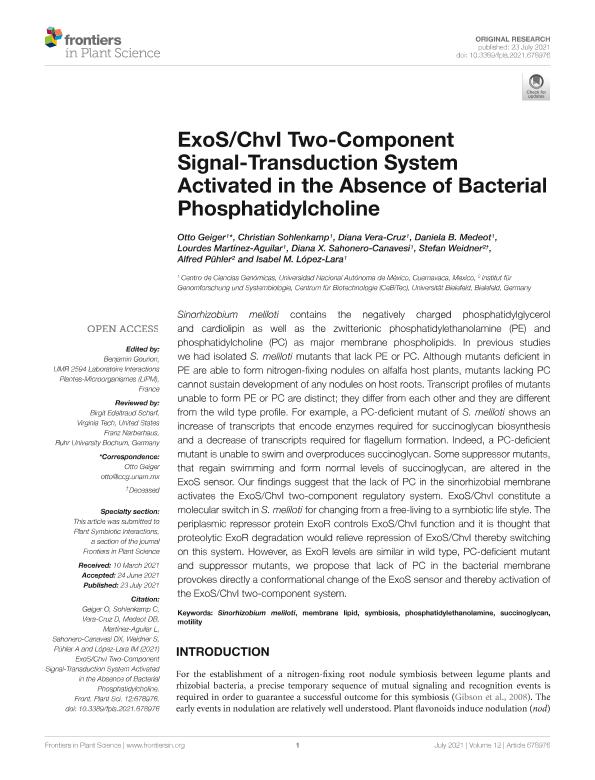Artículo
ExoS/ChvI two-component signal-transduction system activated in the absence of bacterial phosphatidylcholine
Geiger, Otto; Sohlenkamp, Christian; Vera-Cruz, Diana; Medeot, Daniela Beatriz ; Martínez-Aguilar, Lourdes; Sahonero-Canavesi, Diana X.; Weidner, Stefan; Pühler, Alfred; López Lara, Isabel M.
; Martínez-Aguilar, Lourdes; Sahonero-Canavesi, Diana X.; Weidner, Stefan; Pühler, Alfred; López Lara, Isabel M.
 ; Martínez-Aguilar, Lourdes; Sahonero-Canavesi, Diana X.; Weidner, Stefan; Pühler, Alfred; López Lara, Isabel M.
; Martínez-Aguilar, Lourdes; Sahonero-Canavesi, Diana X.; Weidner, Stefan; Pühler, Alfred; López Lara, Isabel M.
Fecha de publicación:
23/07/2021
Editorial:
Frontiers Media S.A.
Revista:
Frontiers in Plant Science
e-ISSN:
1664-462X
Idioma:
Inglés
Tipo de recurso:
Artículo publicado
Clasificación temática:
Resumen
Sinorhizobium meliloti contains the negatively charged phosphatidylglycerol and cardiolipin as well as the zwitterionic phosphatidylethanolamine (PE) and phosphatidylcholine (PC) as major membrane phospholipids. In previous studies we had isolated S. meliloti mutants that lack PE or PC. Although mutants deficient in PE are able to form nitrogen-fixing nodules on alfalfa host plants, mutants lacking PC cannot sustain development of any nodules on host roots. Transcript profiles of mutants unable to form PE or PC are distinct; they differ from each other and they are different from the wild type profile. For example, a PC-deficient mutant of S. meliloti shows an increase of transcripts that encode enzymes required for succinoglycan biosynthesis and a decrease of transcripts required for flagellum formation. Indeed, a PC-deficient mutant is unable to swim and overproduces succinoglycan. Some suppressor mutants, that regain swimming and form normal levels of succinoglycan, are altered in the ExoS sensor. Our findings suggest that the lack of PC in the sinorhizobial membrane activates the ExoS/ChvI two-component regulatory system. ExoS/ChvI constitute a molecular switch in S. meliloti for changing from a free-living to a symbiotic life style. The periplasmic repressor protein ExoR controls ExoS/ChvI function and it is thought that proteolytic ExoR degradation would relieve repression of ExoS/ChvI thereby switching on this system. However, as ExoR levels are similar in wild type, PC-deficient mutant and suppressor mutants, we propose that lack of PC in the bacterial membrane provokes directly a conformational change of the ExoS sensor and thereby activation of the ExoS/ChvI two-component system.
Archivos asociados
Licencia
Identificadores
Colecciones
Articulos (INBIAS)
Articulos de INSTITUTO DE BIOTECNOLOGIA AMBIENTAL Y SALUD
Articulos de INSTITUTO DE BIOTECNOLOGIA AMBIENTAL Y SALUD
Citación
Geiger, Otto; Sohlenkamp, Christian; Vera-Cruz, Diana; Medeot, Daniela Beatriz; Martínez-Aguilar, Lourdes; et al.; ExoS/ChvI two-component signal-transduction system activated in the absence of bacterial phosphatidylcholine; Frontiers Media S.A.; Frontiers in Plant Science; 12; 23-7-2021; 1-20
Compartir
Altmétricas



